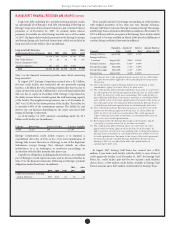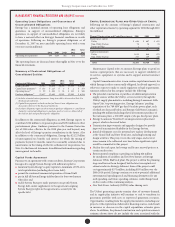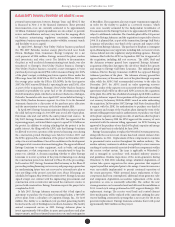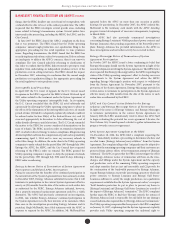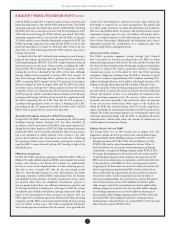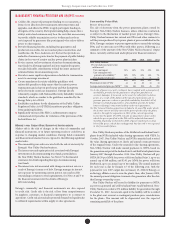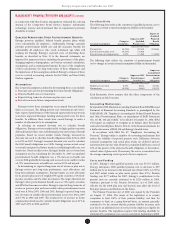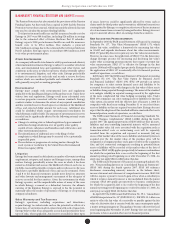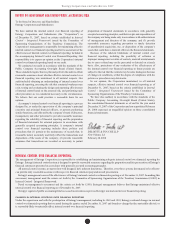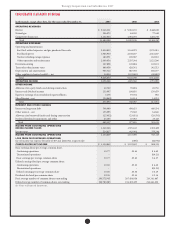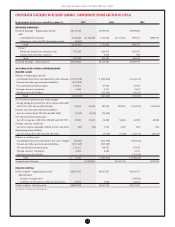Entergy 2007 Annual Report Download - page 47
Download and view the complete annual report
Please find page 47 of the 2007 Entergy annual report below. You can navigate through the pages in the report by either clicking on the pages listed below, or by using the keyword search tool below to find specific information within the annual report.
45
Entergy Corporation and Subsidiaries 2007
terminate its participation in the System Agreement upon 96 months
written notice to the other Utility operating companies. is right is
absolute and unambiguous and is not conditioned or limited in any
way, as the LPSC’s complaint would suggest. e unilateral right to
terminate has been in the System Agreement at least since 1973 and
the agreement has been litigated before the FERC by the LPSC on
numerous occasions. At no point has the LPSC raised this issue nor
has the FERC determined the termination provision to be unjust
or unreasonable.
In June 2007 the FERC denied the LPSC’s complaint on the basis
that it was premature. e FERC’s order indicates that the FERC will
evaluate at the time of Entergy Arkansas’ departure whether “the
System Agreement will remain just and reasonable for the remaining
members … and likewise that any new Entergy Arkansas jurisdictional
wholesale arrangements will be just and reasonable.” e FERC Order
goes on to state that “in light of the history and nature of the existing
members’ planning and operation of their facilities under the System
Agreement, it is possible it may ultimately be appropriate to require
transition measures or other conditions to ensure just and reasonable
wholesale rates and services” upon the termination of Entergy
Arkansas’ participation in the current System Agreement.
Calcasieu Generating Facility Acquisition
In conjunction with the application of Entergy Gulf States and
Calcasieu Power, LLC seeking FERC approval of Entergy Gulf States
Louisiana’s acquisition of the Calcasieu Generating Facility, the
Utility operating companies led a Petition for Declaratory Order
requesting that the FERC nd either (1) that in those circumstances
where a resource to be acquired or constructed has been determined
by Entergy’s Operating Committee to be a resource devoted to serving
Entergy System load and has been approved by the applicable retail
regulator, the cost of such resource shall be reected in the rough
production cost equalization calculation; or (2) that Entergy Gulf
States Louisiana’s acquisition of the Calcasieu facility is prudent and the
costs are properly reected in the rough production cost equalization
calculation. e APSC, LPSC, MPSC, City Council, and several other
parties intervened in the proceeding, with the APSC, LPSC, and City
Council ling protests. In July 2007 the FERC denied the application
for a declaratory order. e FERC concluded that (1) the circumstances
surrounding resource acquisition on the Entergy System were not of
sucient “local interest” to warrant the FERC deferring to the ndings
of the applicable regulator; and (2) with respect to the alternative
request for relief, consistent with its prior precedent, the FERC would
not “entertain the issue of the prudence of a purchase until such time
as the purchaser passes on the cost of the purchase to its customers.”
In a subsequent order issued in November 2007, the FERC approved
Entergy Gulf States Louisiana’s acquisition of the plant.
Independent Coordinator of Transmission
In 2000, the FERC issued an order encouraging utilities to voluntarily
place their transmission facilities under the control of independent
RTOs (regional transmission organizations). Delays in implementing
the FERC RTO order occurred due to a variety of reasons, including
the fact that utility companies, other stakeholders, and federal and
state regulators have had to work to resolve various issues related to
the establishment of such RTOs.
In November 2006, aer nearly a decade of eort, including
lings, orders, technical conferences, and proceedings at the FERC,
the Utility operating companies installed the Southwest Power Pool
(SPP) as their Independent Coordinator of Transmission (ICT).
e installation does not transfer control of Entergy’s transmission
system to the ICT, but rather vests with the ICT responsibility for:
n granting or denying transmission service on the Utility operating
companies’ transmission system.
n administering the Utility operating companies’ Open Access
Same Time Information Systems (OASIS) node for purposes
of processing and evaluating transmission service requests and
ensuring compliance with the Utility operating companies’
obligation to post transmission-related information.
n developing a base plan for the Utility operating companies’
transmission system that will result in the ICT making the
determination on whether costs of transmission upgrades should
be rolled into the Utility operating companies’ transmission rates
or directly assigned to the customer requesting or causing an
upgrade to be constructed. is should result in a transmission
pricing structure that ensures that the Utility operating companies’
retail native load customers are required to pay for only those
upgrades necessary to reliably serve their needs.
n serving as the reliability coordinator for the Entergy transmission
system.
n overseeing the operation of the weekly procurement process (WPP).
n evaluating interconnection-related investments already made on the
Entergy System for purposes of determining the future allocation of
the uncredited portion of these investments, pursuant to a detailed
methodology. e ICT agreement also claries the rights that
customers receive when they fund a supplemental upgrade.
e initial term of the ICT is four years, and Entergy is precluded from
terminating the ICT prior to the end of the four-year period.
Aer the FERC issued its April 2006 order approving the ICT
proposal, the Utility operating companies made a series of compliance
lings with the FERC that were protested by various parties. e FERC
has accepted the compliance lings and denied various requests for
rehearing, although appeals of the FERC’s ICT orders are currently
pending in the U.S. Court of Appeals for the D.C. Circuit. As stated
above, SPP was installed as the ICT in November 2006.
In October 2006 the Utility operating companies led revisions
to their Open Access Transmission Tari (OATT) with the FERC to
establish a mechanism to recover from their wholesale transmission
customers the (1) costs incurred to develop or join an RTO and to
develop the ICT; and (2) on-going costs that will be incurred under
the ICT agreement. Several parties intervened opposing the proposed
tari revisions. In December 2006 the FERC accepted for ling
Entergy’s proposed tari revisions, and set them for hearing and
settlement procedures. In its Order, the FERC concluded that each of
the Utility operating companies “should be allowed the opportunity
to recover its start up costs associated with its formation of the ICT
and its participation in prior failed attempts to form an RTO,” and also
that the proposed taris raised issues of fact that are more properly
addressed through hearing and settlement procedures. In June 2007
the Utility operating companies reached a settlement-in-principle with
the parties to the proceeding and the FERC approved the settlement in
November 2007.
In the FERC’s April 2006 order that approved Entergy’s ICT proposal,
the FERC stated that the weekly procurement process (WPP) must be
operational within approximately 14 months of the FERC order, or June
24, 2007, or the FERC may reevaluate all approvals to proceed with the
ICT. e Utility operating companies have been working with the ICT
and a soware vendor to develop the soware and systems necessary
to implement the WPP. e Utility operating companies also led
Management’s Financial Discussion and Analysis conti nued


